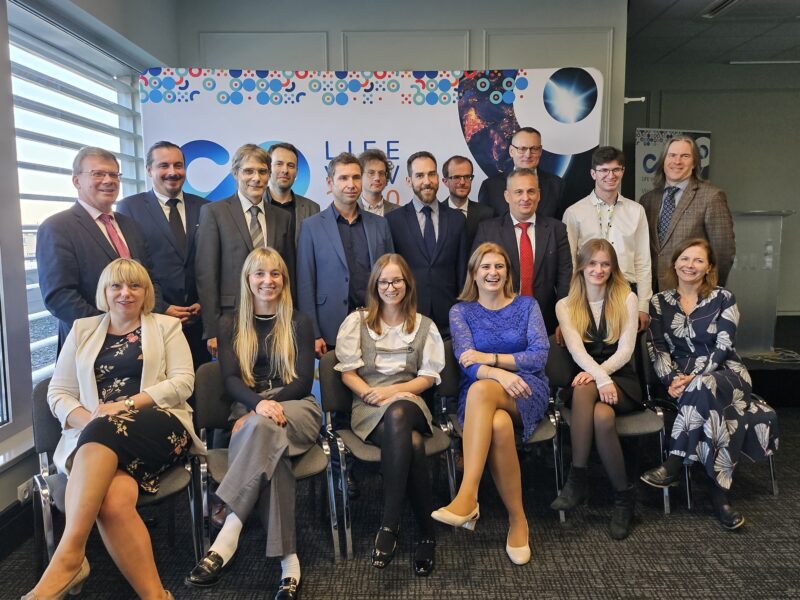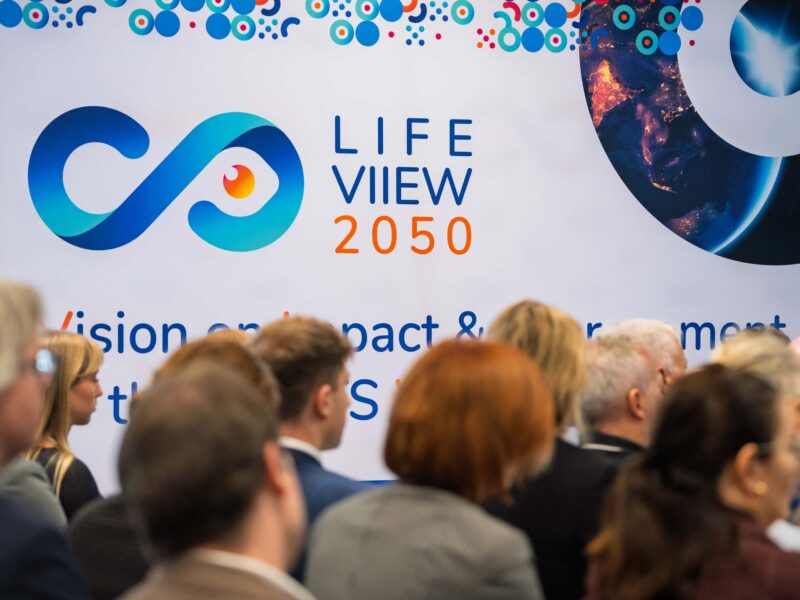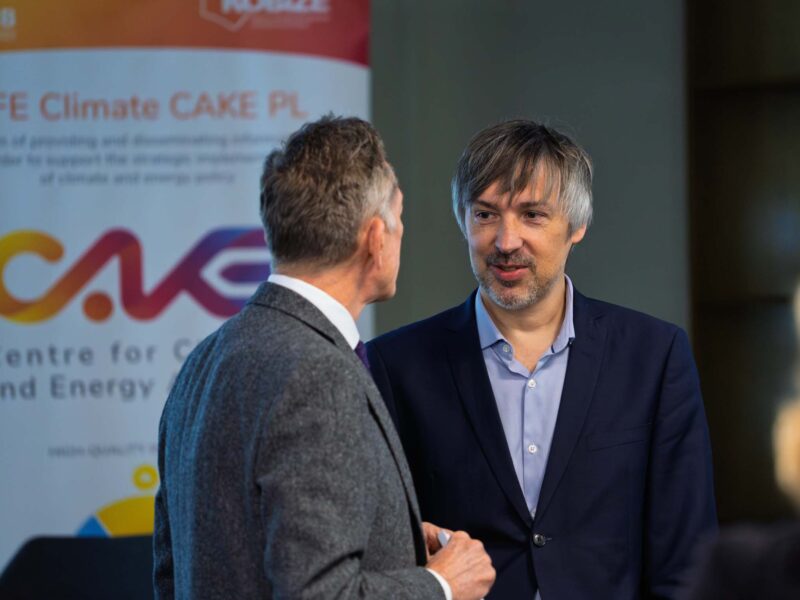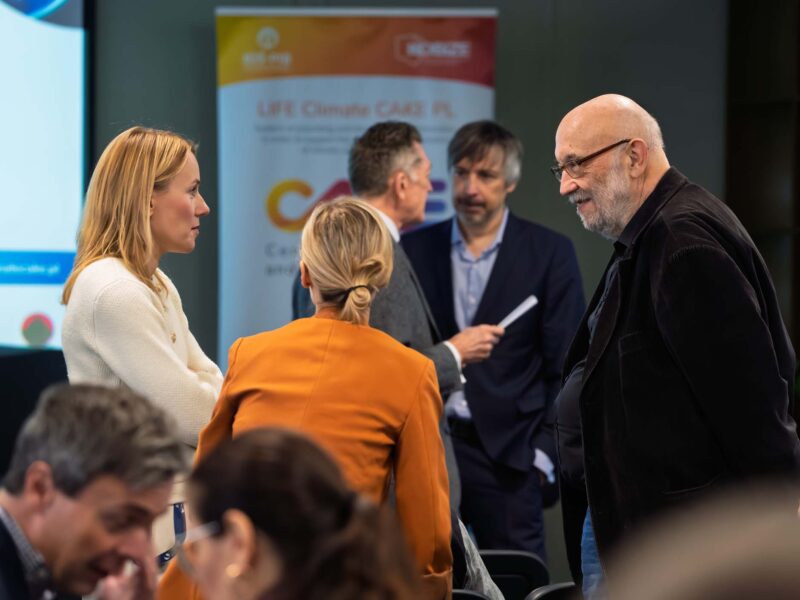CAKE LIFE VIIEW 2050 conference – future of the EU ETS
On October 25, 2024, at the headquarters of IOŚ-PIB in Warsaw, CAKE organized the LIFE VIIEW 2050 project conference, co-funded by the LIFE programme and NFOŚiGW, titled “Shaping the Future of the EU ETS: Achieving 2050 Climate Neutrality with Insights from the New European Commission and the Polish Presidency”. The event was attended by experts in climate policy and the EU ETS, as well as representatives of the European Commission, the public sector, and industry.

Welcome and Opening Remarks
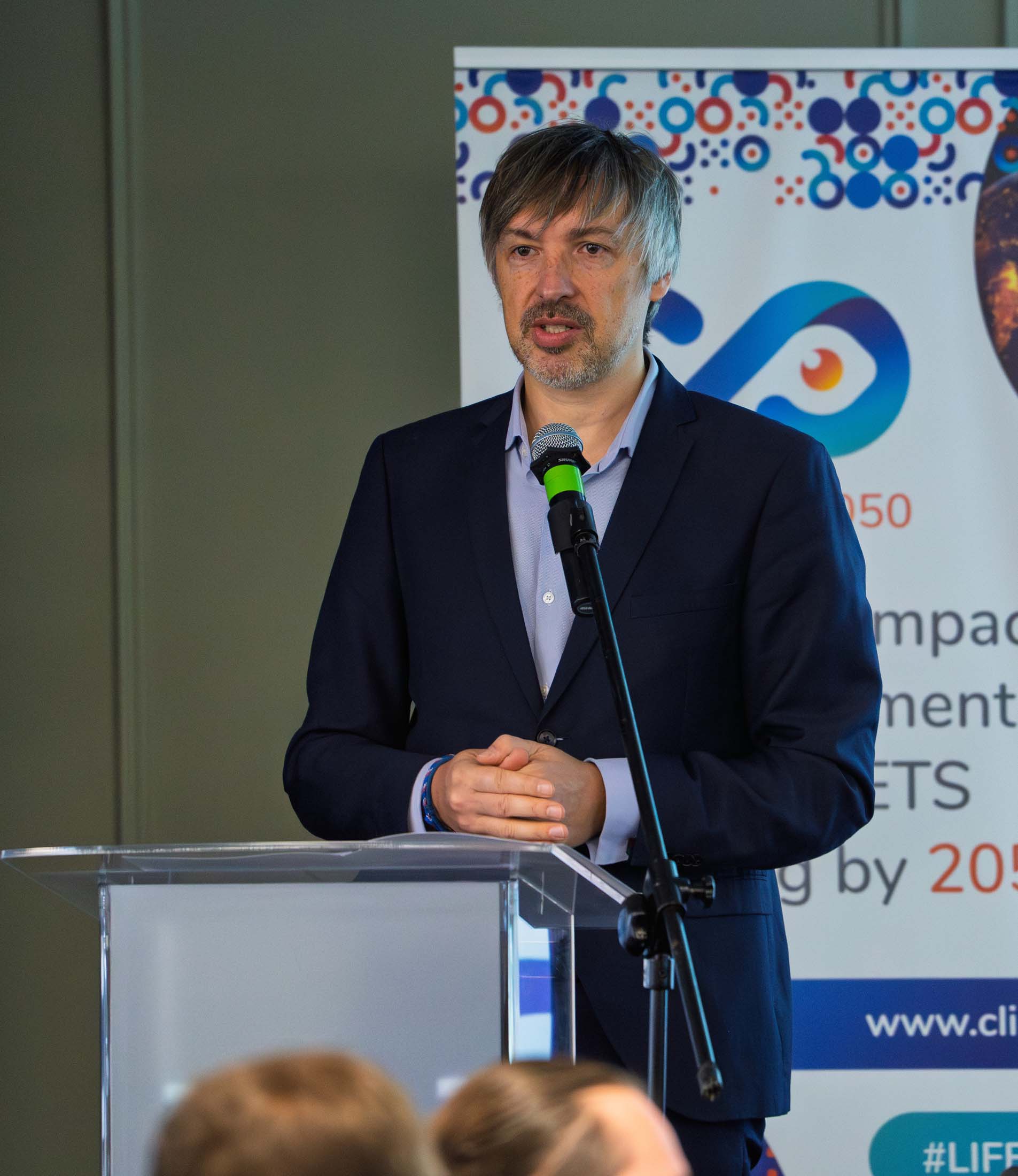 The conference was opened by Krzysztof Bolesta, Secretary of State at the Ministry of Climate and Environment. He expressed gratitude to the Institute of Environmental Protection – National Research Institute (IOŚ-PIB), emphasizing the importance of the topics discussed, which reflect a critical moment in climate policy history. He highlighted the significance of setting new climate targets for 2040 by the European Commission and the contributions of the LIFE programme to the development of national environmental projects. The Centre for Climate and Energy Analyses (CAKE), a result of collaboration with the World Bank, was built upon LIFE projects and stands as a valuable asset for Polish institutions on the international stage. Bolesta also noted that through the collaboration of IOŚ-PIB, NFOŚiGW, and the Ministry of Climate and Environment (MKiŚ), Poland has access to unique data and analyses that bring genuine value at both the European and global levels. The upcoming Polish Presidency in the EU will also serve as an opportunity to implement key 2040 goals.
The conference was opened by Krzysztof Bolesta, Secretary of State at the Ministry of Climate and Environment. He expressed gratitude to the Institute of Environmental Protection – National Research Institute (IOŚ-PIB), emphasizing the importance of the topics discussed, which reflect a critical moment in climate policy history. He highlighted the significance of setting new climate targets for 2040 by the European Commission and the contributions of the LIFE programme to the development of national environmental projects. The Centre for Climate and Energy Analyses (CAKE), a result of collaboration with the World Bank, was built upon LIFE projects and stands as a valuable asset for Polish institutions on the international stage. Bolesta also noted that through the collaboration of IOŚ-PIB, NFOŚiGW, and the Ministry of Climate and Environment (MKiŚ), Poland has access to unique data and analyses that bring genuine value at both the European and global levels. The upcoming Polish Presidency in the EU will also serve as an opportunity to implement key 2040 goals.
 Marcin Stoczkiewicz, Director of IOŚ-PIB, pointed out that Poland’s approach to the EU ETS has long been cautious, viewing the system primarily as a financial burden on the energy and industrial sectors. However, recent developments indicate an evolving perspective on ETS among decision-makers, who now recognize it not only as a source of costs but also as a tool with a significant potential. He stressed the importance of discussing EU ETS from both Polish and European perspectives, particularly in the context of building an energy security framework for the entire EU.
Marcin Stoczkiewicz, Director of IOŚ-PIB, pointed out that Poland’s approach to the EU ETS has long been cautious, viewing the system primarily as a financial burden on the energy and industrial sectors. However, recent developments indicate an evolving perspective on ETS among decision-makers, who now recognize it not only as a source of costs but also as a tool with a significant potential. He stressed the importance of discussing EU ETS from both Polish and European perspectives, particularly in the context of building an energy security framework for the entire EU.
Panel 1: Challenges in climate and energy policy: Navigating the future of the EU ETS under the new European Commission and Polish Presidency
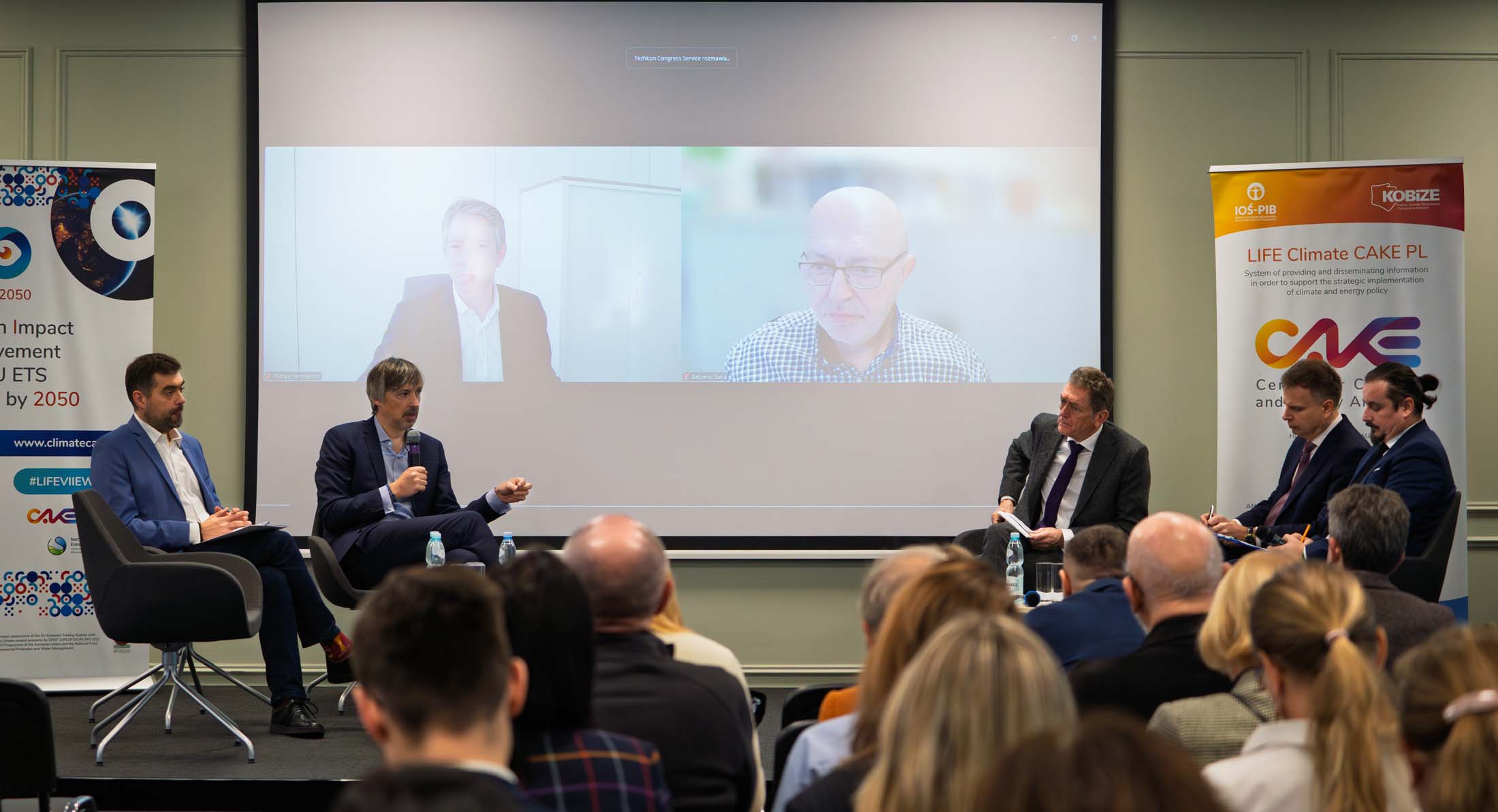
The first panel gathered experts from both the public and industrial sectors, including representatives of the European Commission and energy and chemical sector organizations. The panel, moderated by Robert Jeszke, Deputy Director for Emissions Management at IOŚ-PIB, KOBIZE and CAKE CEO, addressed several critical topics:
- Polish Presidency of the EU Council in 2025, coinciding with the start of the new European Commission’s work,
- New climate targets for 2040,
- The implementation of “Fit for 55” package and the significant challenges through 2030,
- The 2026 review of the EU ETS directive, which will be an opportunity to set new climate priorities,
- The start of discussions on ETS3 in the context of incorporating agriculture and its importance to the EU’s food security.
In the context of the Polish Presidency in the EU Council, Minister Krzysztof Bolesta highlighted three main priorities:
- Adaptation to climate change, an area that has so far been more focused on emission reduction within the EU,
- Combating misinformation, especially digital misinformation related to climate and energy policy,
- Supporting the “Clean Industrial Deal,” which requires an economic policy balanced to include adaptation measures.
Minister Krzysztof Bolesta emphasized that ETS2 is a particularly challenging —improper implementation could stall EU climate policy progress. Therefore, caution is crucial to maintain public acceptance and trust in climate actions. He also noted that ETS has a “short expiration date,” running only until 2030, which is crucial for essential investments. Extending this timeline is therefore an urgent issue. Beyond ETS1 and ETS2, implementing climate law and adapting transportation regulations will also be vital.
Ruben Vermeeren from the European Commission underscored that new sectors, including transport, present unique challenges as their emissions continue to rise. The implementation of ETS2 will require technical support and emissions monitoring by fuel suppliers. The implementation of ETS2 at the member state level is already challenging – 18 EU member states encountered difficulties meeting the deadline set by the European Commission (June 30, 2024). However, progress is visible in cooperation with member states. Complementary actions, such as developing charging infrastructure and supporting building renovations, will be crucial for effectively reducing emissions. The Social Climate Fund (SCF) will start one year earlier than ETS2. Member states should use SCF revenues not only to support consumers but also to effectively reduce ETS2 emissions, which should lead to reduced demand and CO2 prices. The EU ETS is the central pillar of the EU’s climate policy, while ETS2 can be seen as a complementary policy that includes mechanisms like CBAM and voluntary market (VCM). The EU ETS has proven effective, motivating non-EU countries to engage in emissions reductions and adopt carbon pricing mechanisms. The European Commission is currently working on certifying removals (CDR) under the EU ETS.
Artur Runge-Metzger, former Director of DG Clima at the European Commission, was asked about lessons learned from the functioning of the EU ETS so far. He stressed the importance of accurate forecasting when designing the system and responding appropriately to any potential gaps. As an example of system malfunction, he mentioned the over-allocation of EU ETS allowances caused by too many CER units, later requiring backloading and the MSR mechanism to correct the system. ETS2 may face similar risks, so preventive measures from the start will be crucial to ensure an effective system. Regarding ETS3 and agricultural reductions, he noted that the system’s protection (for farmers) should be similar to that applied to energy-intensive sectors under ETS1. Farmers should be able to protect their products from carbon leakage while also developing more sustainable technologies. New technologies for agriculture are available, but no one is using them as there is no incentive. Therefore, the system should encourage European farmers to produce “cleaner” and make it more profitable for them. EU climate policy should be supplemented by complementary instruments enabling agriculture to adapt to market realities without incurring excessive costs.
Antonio Soria from JRC discussed the effects and challenges of expanding ETS into new sectors and the technological advancements that will enable more effective reductions. He also emphasized the importance of collaboration with CAKE in modeling policy scenarios to accelerate European Commission decision-making processes.
Tomasz Zieliński from the Polish Chamber of Chemical Industry highlighted that the EU ETS presents a challenge for the chemical sector across the EU due to its significant impact on energy costs (process emissions) and competitiveness (high costs). He suggested that delaying the phase-out of free allowances would support the industry and limit carbon leakage. CBAM also significantly influences the sector’s competitiveness.
Tomasz Świetlicki from PGE presented PGE’s plans for investments in renewable energy sources and energy storage. He noted that rising emission allowance costs pose a challenge, and after 2030, the EU budget for the transformation will cover only 11% of the required funds, underscoring the need for a systematic approach to transforming the heating sector. He highlighted that rising allowance prices account for around 10% of energy costs, making the EU ETS one of the most expensive trading systems globally. It will be essential after 2030 to extend the Modernization Fund, increase its budget, and maintain an appropriate geographical balance.
Panel 2: The role and achievements of the LIFE programme and the presentation of the LIFE VIIEW 2050 project and the launch of the LIFE ENSPIRE project
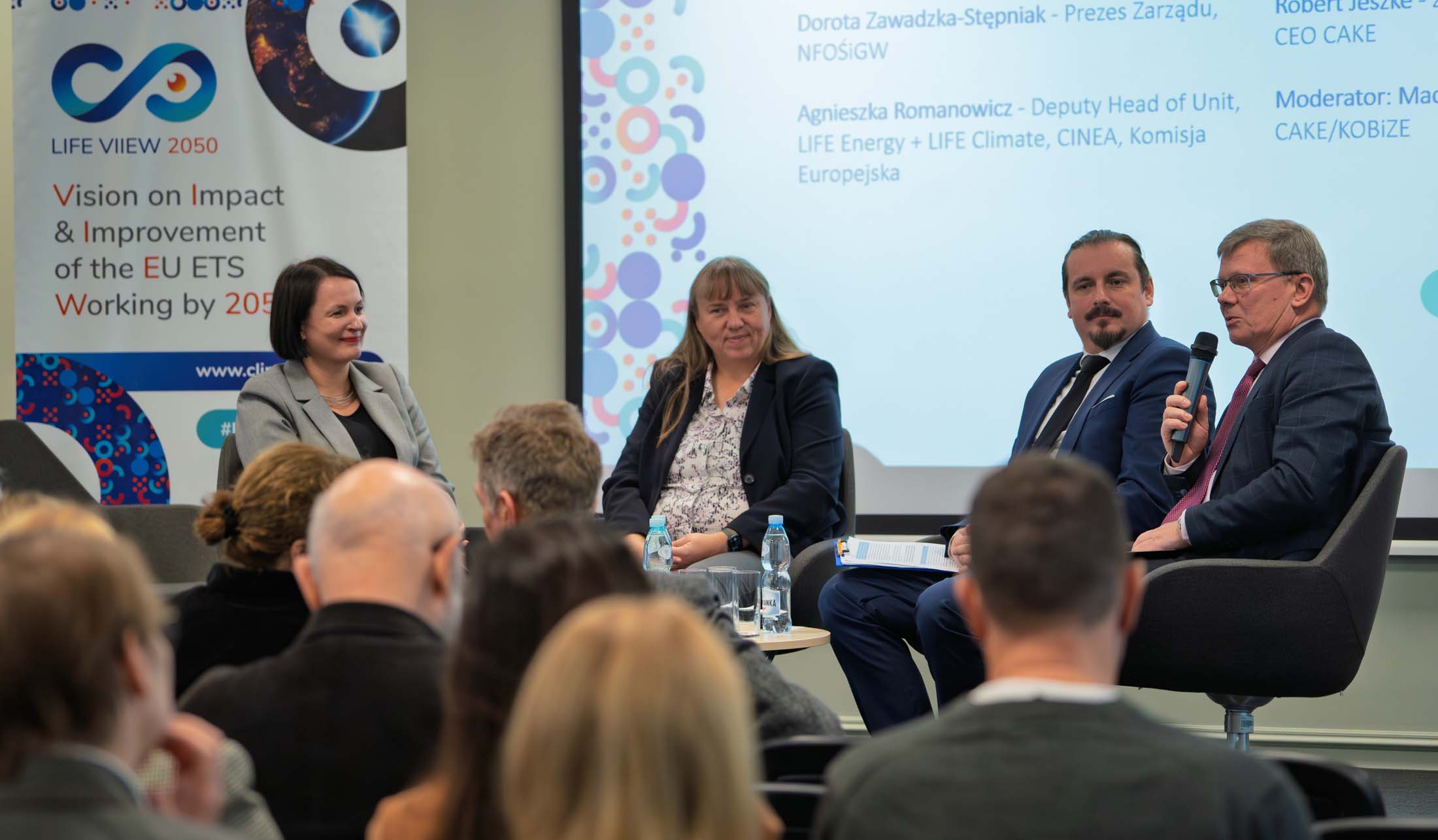
The second panel, moderated by Maciej Cygler from CAKE, focused on the contribution of the LIFE programme to climate projects. Dorota Zawadzka-Stępniak, President of the Management Board NFOŚiGW, noted that Poland has actively used this programme since 1992, supporting environmental and climate projects. LIFE has enabled the realization of over 115 projects related to climate adaptation and mitigation, with Poland leading strategic LIFE projects in the EU. NFOŚiGW also launched a dedicated project incubator to help applicants prepare applications for LIFE funding.
Agnieszka Romanowicz from CINEA (European Commission) highlighted that the future of the LIFE programme will focus on citizen health and new environmental initiatives. In the context of the new financial perspective after 2027, there will be an increased emphasis on public-private cooperation.
Robert Jeszke, Deputy Director at IOŚ-PIB, KOBiZE and CAKE CEO presented the results of the LIFE VIEW 2050 project, focusing on insights related to the modeling and achieving net-zero goals. He emphasized that the LIFE programme has played a key role in transforming the Polish economy since the early 1990s. LIFE projects implemented by IOŚ-PIB, including LIFE VIEW 2050, allow for the continuous development of analytical tools that support achieving climate goals. One of the main objectives is also to develop mechanisms based on carbon pricing outside the EU. The analytical tools created at CAKE can support future EU member countries’ analyses, such as the Balkans and Ukraine. The upcoming CAKE project, LIFE ENSPIRE, will focus on these activities, aiming to provide decision-makers in Poland, the European Commission, and neighboring countries with comprehensive analyses of the potential expansion of ETS to new regions, assessing the economic and social impacts.
Findings of the LIFE VIIEW 2050 Project and other key analyses in climate and energy policy
Marta Kocoń from the Ministry of Climate and Environment (MKiŚ) presented details regarding Poland’s National Energy and Climate Plan, whose primary goal is to achieve a 50.4% reduction in emissions by 2030 and to increase the share of renewable energy sources (RES) in the energy mix to 60%. She also highlighted the challenges Poland faces in intensifying transformative actions to achieve climate neutrality by 2050.
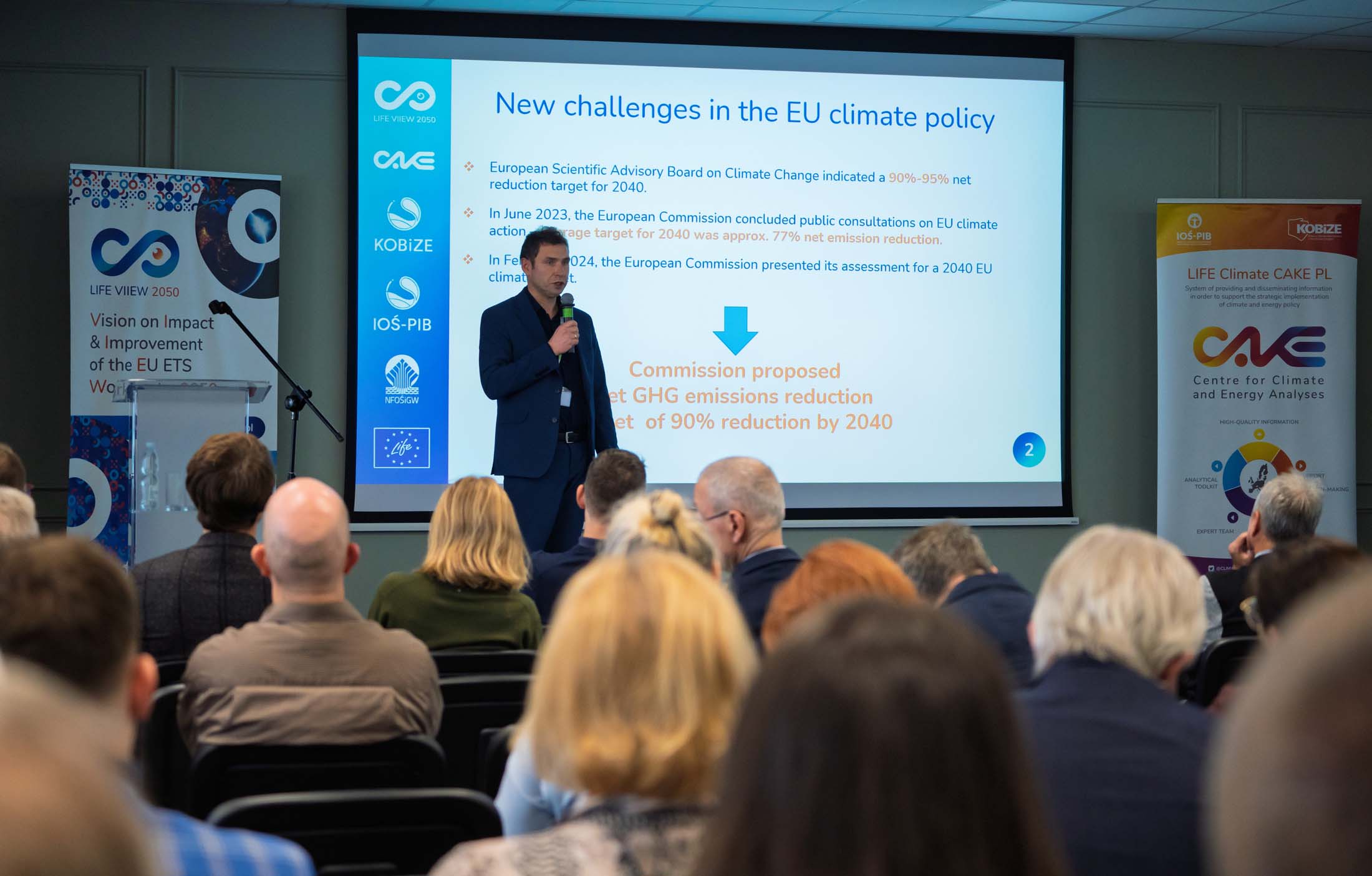 Maciej Pyrka from CAKE/KOBIZE discussed the emission reduction target for 2040. To achieve climate neutrality, the European Commission set an ambitious emissions reduction target of 90-95% by 2040. In February 2024, the European Commission conducted an impact assessment, in which respondents indicated that the reduction target should be around 77%. The Commission opted for 90% target, known as scenario S3. Without changes to the EU ETS, emission allowances could run out by 2040. The key question is how to modify the EU ETS to meet these challenges. Three main options are being considered:
Maciej Pyrka from CAKE/KOBIZE discussed the emission reduction target for 2040. To achieve climate neutrality, the European Commission set an ambitious emissions reduction target of 90-95% by 2040. In February 2024, the European Commission conducted an impact assessment, in which respondents indicated that the reduction target should be around 77%. The Commission opted for 90% target, known as scenario S3. Without changes to the EU ETS, emission allowances could run out by 2040. The key question is how to modify the EU ETS to meet these challenges. Three main options are being considered:
- Expanding the ETS to include new sectors,
- Introducing mechanisms for carbon removals,
- Linking the ETS with other systems outside the EU, including through international offset units.
An impact assessment conducted by the Climate and Energy Analysis Center (CAKE) provides detailed insights into the potential effects of these solutions.
- Presentation:
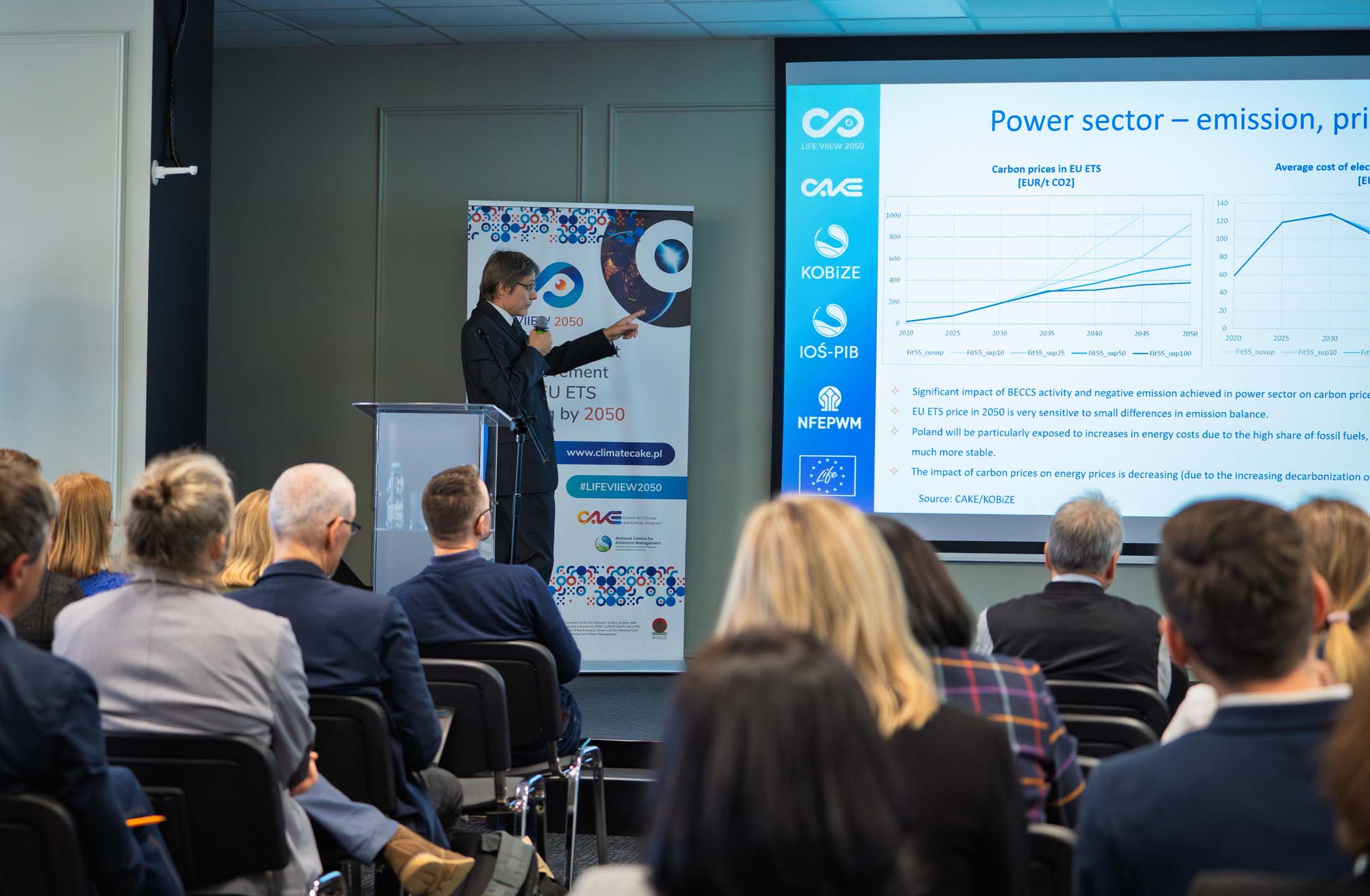 Igor Tatarewicz from CAKE/KOBIZE addressed the technical aspects of emissions removals in the energy sector and the role of advanced models used for EU-wide emissions analysis. He explained that CAKE’s central tool is the EU general equilibrium model, d-PLACE, which generates energy demand and calculates emission reduction costs. This model works in conjunction with the optimal energy mix model, which estimates energy costs and determines necessary investments. Each calculation cycle for these models takes approximately 22-24 hours, and the costs of emissions in the ETS and other sectors are determined endogenously, providing a comprehensive picture of the economic impact. The sensitivity analysis of these models allows for assessing the impact of different scenarios on EU emission reductions, energy prices, and allowance prices in the ETS. Scenarios involving subsidies for carbon removals, up to 100% of the value obtained in the ETS, are also included. Analysis results show that the energy mix structure remains similar across scenarios, with biomass playing an increasing role as its use receives greater support. With full support for removals, the price of energy in 2050 could reach around EUR 400/MWh; however, projections indicate that energy costs will rise above EUR 120/MWh by 2030 before decreasing. High ETS prices do not significantly affect energy prices, as the energy sector is systematically decarbonizing.
Igor Tatarewicz from CAKE/KOBIZE addressed the technical aspects of emissions removals in the energy sector and the role of advanced models used for EU-wide emissions analysis. He explained that CAKE’s central tool is the EU general equilibrium model, d-PLACE, which generates energy demand and calculates emission reduction costs. This model works in conjunction with the optimal energy mix model, which estimates energy costs and determines necessary investments. Each calculation cycle for these models takes approximately 22-24 hours, and the costs of emissions in the ETS and other sectors are determined endogenously, providing a comprehensive picture of the economic impact. The sensitivity analysis of these models allows for assessing the impact of different scenarios on EU emission reductions, energy prices, and allowance prices in the ETS. Scenarios involving subsidies for carbon removals, up to 100% of the value obtained in the ETS, are also included. Analysis results show that the energy mix structure remains similar across scenarios, with biomass playing an increasing role as its use receives greater support. With full support for removals, the price of energy in 2050 could reach around EUR 400/MWh; however, projections indicate that energy costs will rise above EUR 120/MWh by 2030 before decreasing. High ETS prices do not significantly affect energy prices, as the energy sector is systematically decarbonizing.
Wojciech Rabiega from CAKE presented emission reduction targets within ETS2, aiming for an 87% reduction by 2050 and a ban on the sale of combustion vehicles from 2035. He highlighted the need for profound changes in the transport sector to meet these targets. He emphasized that emission reductions cannot be achieved solely by reducing transport activity, as demand for transport services is expected to grow by up to 60%. Achieving the reduction target will require changes in the transport structure, both passenger and freight. One example is the increased scrappage rate of passenger vehicles, which has already lowered the average age of vehicles in the EU by two years. Further steps include tightening emissions standards for trucks, targeting a 90% reduction by 2040. A crucial aspect of the plan is the gradual phase-out of gasoline- and diesel-powered vehicles, both in the EU and in Poland. Between 2030 and 2050, demand for electricity in transport is expected to increase significantly, leading to an 87% reduction in fossil fuel consumption.
 Paweł Kobus from CAKE discussed the challenges and constraints facing the agricultural sector in the context of emissions reduction. He pointed out that activities such as afforestation of agricultural land require financial support exceeding the costs of establishing a forest. A support level of around 50% has proven sufficient to achieve significant emissions reductions. However, he noted that imposing carbon price on emissions in agricultural sector could have negative effects, as existing subsidies do not offset rising emission costs. As a result, agricultural production in Poland would decrease slightly by 2030, with a significantly larger decline in later years. The lack of available low-emission technologies in agriculture – unlike in the energy sector, which can use nuclear power – also presents a challenge. Current technologies can reduce emissions in agriculture only marginally, by about 25% at most. To meet reduction targets, agricultural production would need to be reduced by about 40% in Poland, which would have serious consequences given that Poland is a major food exporter. Such a reduction in production would necessitate food imports, generating additional emissions abroad (carbon leakage). Therefore, emissions charges for agriculture should be introduced very cautiously, taking into account the sector’s specific characteristics and capabilities.
Paweł Kobus from CAKE discussed the challenges and constraints facing the agricultural sector in the context of emissions reduction. He pointed out that activities such as afforestation of agricultural land require financial support exceeding the costs of establishing a forest. A support level of around 50% has proven sufficient to achieve significant emissions reductions. However, he noted that imposing carbon price on emissions in agricultural sector could have negative effects, as existing subsidies do not offset rising emission costs. As a result, agricultural production in Poland would decrease slightly by 2030, with a significantly larger decline in later years. The lack of available low-emission technologies in agriculture – unlike in the energy sector, which can use nuclear power – also presents a challenge. Current technologies can reduce emissions in agriculture only marginally, by about 25% at most. To meet reduction targets, agricultural production would need to be reduced by about 40% in Poland, which would have serious consequences given that Poland is a major food exporter. Such a reduction in production would necessitate food imports, generating additional emissions abroad (carbon leakage). Therefore, emissions charges for agriculture should be introduced very cautiously, taking into account the sector’s specific characteristics and capabilities.
- Presentation:
 Impact of possible changes in the EU ETS on the energy, transport, and agriculture sectors (4.1 MiB, 111 hits)
Impact of possible changes in the EU ETS on the energy, transport, and agriculture sectors (4.1 MiB, 111 hits) - Coverage of the event: https://www.youtube.com/watch?v=FcQ8lL6w0BU

 Reset ustawień
Reset ustawień Kontrast
Kontrast Widok
Widok Czytelność
Czytelność Czcionka
Czcionka Znaki
Znaki Interlinia
Interlinia Słowa
Słowa Akapity
Akapity Deklaracja dostępności
Deklaracja dostępności




